An individual may have popped blood vessels when there is damage to skin that causes the underneath blood veins to rupture. Different things may cause popped blood vessels, for example accidents and falls that result in bruising. At other times, ruptured blood vessels may occur from genetic and aging. Popped blood vessels will mostly heal without an individual having any treatment, however, there are things that could hasten and enhance the healing process.
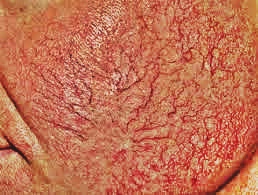
What does a popped blood vessel look like?
When blood vessels underneath an individual’s skin burst, you may have little amount of blood escaping into the tissue. That blood shows up beneath the skin’s surface. Bleeding into a person’s skin may manifest in form of small dots known as patechiae and in other times, it can appear in form of larger, flat patches known as purpura. Sometimes, certain birthmarks may be confused with popped blood vessels or bleeding into an individual’s skin.
In normal situations, when you press on the skin, it turns pale and after you release the pressing, color or redness returns. In case of bleeding into a person’s skin, when you press down on the skin, it does not become pale, the redness remains. A minor occurrence like bruising may be the culprit to bleeding underneath the skin. The bleeding may appear as tiny dots taking the size of a pinprick, but in other times, it can be a large patch that takes the size of an adult hand. If you have signs of bleeding to your skin, and it isn’t related to an injury, you should get to a doctor’s office.
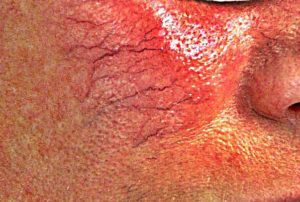
Causes of Popped Blood Vessels
Popping of blood vessels can occur due to many reasons and they include:
- Injury
- Bruises
- Birth
- Autoimmune disorders
- Blood infections
- Chemotherapy side effects
- Aging
- Radiation side effects
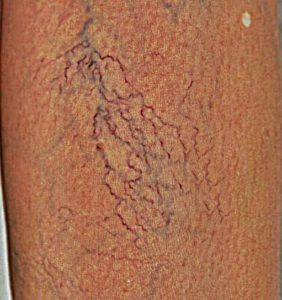
Popped Blood Vessels on Face
When you notice that there are popped or ruptured blood vessels on an individual’s face, they could be spider veins. These occur when there is dilation or enlargement of veins underneath an individual’s skin surface. The vessels appear as small, red lines and may form a web-shaped appearance. They are harmless, but when you begin to think about them and make you become self-conscious, they can affect your self esteem. Luckily, spider veins are treatable.
Having broken blood vessels within the face may be due to genetic or hereditary factors. For some unknown reasons, you may find that certain individuals tend to have spider veins than others. The condition runs in families.
Pregnancy may also be attributed to popped blood vessels. During pregnancy, there is an increase in estrogen. This hormone is associated with broken blood veins. Usually, spider veins or broken veins occurring during pregnancy tend to resolve on their own. It is common to have broken blood vessel when you have a form of rosacea known as erythematotelangiectatic rosacea. It causes excessive redness as well as flushing to occur on a person’s skin.
Exposure to sun is another reason you may be seeing broken veins on face. When there is too much exposure to sunlight, it makes the blood vessels to dilate. When you have sunburn, it may cause the upper skin layer to start peeling and expose the blood vessels. Again, hot weather increases vein’s dilation and it could be the reason you’re seeing the popped blood veins on your face.
Alcohol consumption may make the skin to flush because of bulging blood vessels. Having binge drinking may in the end contribute to spider veins on a person’s face. Injuries are also likely to cause broken veins on a person’s face. The sudden and extreme pressure that is created on your face when you violently sneeze or when you vomit may make blood vessels to dilate and rupture or become popped.
Chemicals and irritants you apply on face may be another reason you are having popped blood veins.
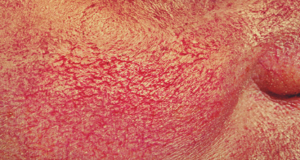
Popped Blood Vessels in Eyes
When you have broken blood vessels within the eyes, it may be a condition known as subconjunctival hemorrhage. This occurs after the small vessels underneath the conjunctiva or the clear eye’s surface rupture. An individual may not know they have a subconjunctival hemorrhage until they look into a minor and realize that the white part of their eye has a bright red appearance. A subconjunctival hemorrhage may occur without posing any harm to the individual’s eye.
A subconjunctival hemorrhage presents with a bright red patch within the sclera or white of eye. This is the most obvious sign of the condition. Although the eye appears red, a subconjunctival hemorrhage should not interfere with vision or have pain and discharge. However, there may be some scratchy feeling occurring within the eye’s surface.
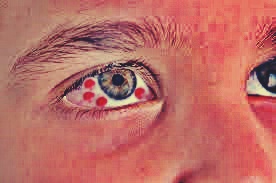
Causes of subconjunctival hemorrhage include:
- Heavy lifting
- Eye trauma
- Rubbing the eyes
- Having eye surgery like cataract surgery or LASIK
- Using medications like aspirin and blood thinners like Warfarin or Coumadin
- Straining caused by constipation
- An abruptly increased blood pressure arising from sneezing, coughing, or laughing.
The blood vessels in your eyes are pretty small and it won’t take a lot of pressure or say intense trauma to make them burst. Just rubbing the eyes somehow can make then rupture. However, that doesn’t mean you should be going to the emergency room (ER). The condition will resolve by itself. However, there is an exception for a person having broken vessels in their eye. For example, if you are hit in your eye so seriously that there is blood collecting behind cornea. This blood is collecting behind the sclera or white of eye and is in front of iris or the colored part of an individual’s eye.
If you can see some line looking really dark, then it may be something more concerning. In this situation, the broken blood vessels aren’t seen behind the sclera, but behind the cornea. This condition is known as hyphema and can bring about increased eye pressure and result in staining of an individual’s eye. That’s when you actually want to head to the ER.
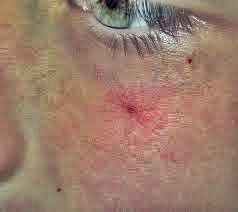
Popped Blood Vessels On Hands
Having popped blood veins in hands can affect how an individual does their daily tasks or chores because a person uses their hands and fingers for do most of the activities and tasks. If there are popped or broken veins in hands or fingers, there may be swelling, inflammation, and pain which make it difficult to take on daily things. The popped blood vessels may be due to an object that hits the finger or vice verse.
For example, when you jam the fingers in a door or when a finger is caught between something like a hammer, it can injure and break the vessels. Age also may bring about broken vessels. An individual’s skin becomes more flexible as they age and also tends to be loose. This flexibility and looseness makes the skin vulnerable to bruising.
If you have small veins breaking in hands and fingers without any obvious reason, it is important that you get examined. High blood pressure can make blood vessels found in fingers to break. Another condition known as Achenbach syndrome, which is a rare disease affecting mostly the fingers and palms may be linked to ruptured or popped veins in fingers. The disease can cause the vessels to swell, inflame, and be painful. If you are taking any medication, you can talk to the physician to see if it could be causing side effects that manifest in form of ruptured blood vessels in hands or fingers.
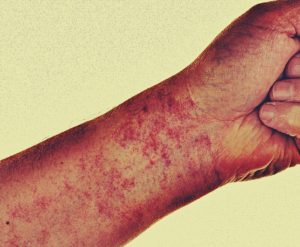
Telangiectasias
When the blood veins found beneath a person’s skin surface or the mucous membranes widen and break or pop, it may be referred to as telangiectasias. The blood veins appear as pinkish to reddish lines and when pressed, they tend to whiten. Usually, when there is rupturing of blood vessels and blood leaks to the surrounding tissue, it may make the area appear reddish, and that redness doesn’t go away when you press on skin.
In telangiectasias, the tiny lines forming on an individual’s skin may have varying colors from red to blue to purple. The lines may be about 1 to 3 mm wide and are harmless. However, they can be itchy and painful due to pressure being put on veins. Telangiectasias occur mainly on an individual’s chin, cheek, nose, and face. The redness occurring on the face is because the vessels are broken, something known as facial spider veins. It is also possible for telangiectasias to occur on chest, arms, back, legs, and other body areas. When telangiectasias occur on legs, they are known as spider veins. Telangiectasias or spider telengiectasias have red, central blood-feeding vessels that branch outward.
In most cases, it’s not known what exactly causes telangiectasias but they are seen more on individuals with fair-skin and have prolonged exposure to sun damage. Telengiectasias can occur anywhere in an individual’s body even in the brain. When they occur on brain or other sensitive areas, they can result in bleeding that causes serious problems.
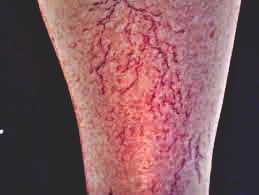
There are factors that may contribute to a person developing telangiectasias and they are:
- Acne
- Pregnancy
- Wind and sun exposure
- Genetics
- Medications capable of widening blood vessels
- Surgical incisions
- Excessive alcohol use
- Prolonged use of topical and oral corticosteroids
- Trauma on skin
How to get rid of popped blood vessel (Treatment)
If you have ruptured, broken, or popped blood vessels, you may just want to wait because eventually they heal without having any form of treatment. It is only that it takes time, and sometimes, you feel that it’s a cosmetic issue affecting your look. It may take about 2 to 3 weeks for the broken or popped vessels to heal. After healing, the skin should be able to get back to normal, no expected long term damage.
In people who have broken blood vessels, natural remedies can help and they present fewer risks unless an individual has sensitivity to ingredients contained in the remedies.
Apple cider vinegar: A common pantry stable that helps to lessen the look or appearance of broken vessels, apple cider vinegar reduces redness of the vessels. A person can apply vinegar using cotton ball.
Horse chestnut: The National Center for Complementary and Integrative Health says that some individual use horse chestnut to treat spider veins. While there are supplement form of the herb, the topical forms tend to be safer in treating spider veins. You may want to look for horse chestnut preparations that have been made from the herb’s back only.
Cold compress: Using ice pack or cold compress can help reduce swelling and redness. You can take ice and wrap it in a clean cloth then apply it on the skin where the ruptured vessels are found. Alternatively, you can just soak a washcloth or clean cloth in ice water and hold it on the skin for about 5 minutes then remove it and reapply.
Warm water: Because heat is likely to cause blood vessels to break, you should avoid using hot water. You may want to take warm water showers or baths.
When home remedies don’t work, you may see a doctor to get other forms of treatment.
Laser therapy: Doctors may use laser treatment in treating broken or popped blood vessels. With this instrument, it uses light beams that target the darkened pigmentation associated with popped blood vessels. The laser light breaks that pigmentation up and ensures that it is reabsorbed into an individual’s body. It works by fading the spider veins in which case the poorly functioning veins are destroyed. For effective results, a person may need to get multiple sessions of laser treatment.
Intense pulsed light: This is another treatment that applies a similar concept to that of laser therapy. In this case, the light goes down to an individual’s second skin layer but without causing harm to the upper layer.
Sclerotherapy: A doctor uses injection-based therapy to help broken or ruptured vessels or spider veins to go away in a couple of weeks. The solution is injected into the broken vessels making them to close or shrink. The blood then reroutes to nearby vessels that are not visible.
VeinWave: This is a new product that is effective in treating spider veins across different parts of an individual’s body. This technique treats veins that seem to be too tiny for laser therapy or sclerotherapy.
Topical treatment: A person can use products that contain vitamin K, for example serums and creams or lotions. Vitamin K helps keep blood vessels flexible and healthy. Topical creams containing retinoids may also help in reducing the appearance of broken or spider veins. Retinoids are mostly used in case of rosacea or acne that causes rupturing of vessels. Retinoids remove the person’s outermost skin layer.
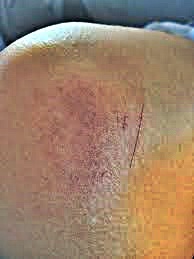

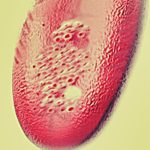

I discovered your blog site on google and check a few of your early posts. Continue to keep up the very good operate. I just additional up your RSS feed to my MSN News Reader. Seeking forward to reading more from you later on!…